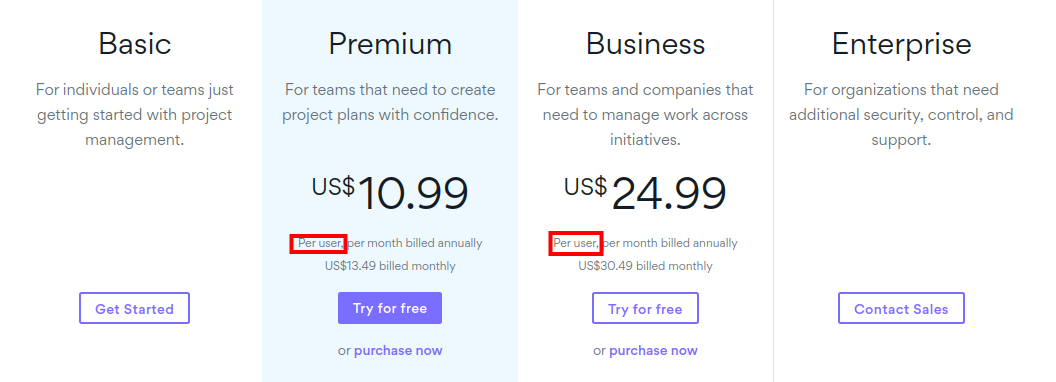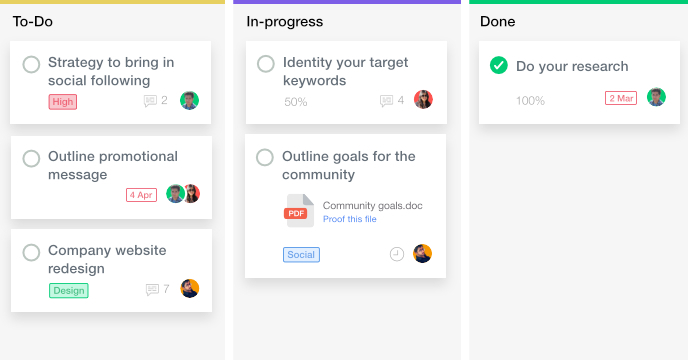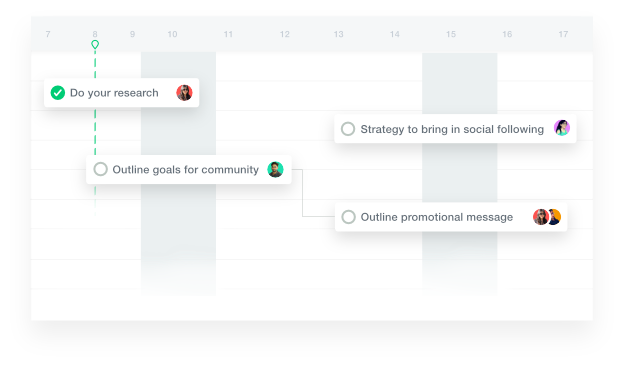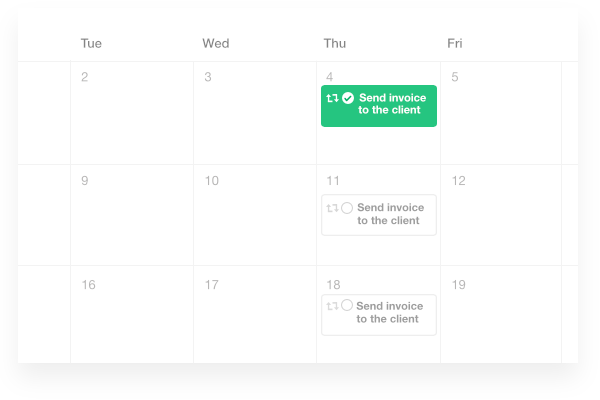It’s “let go of the tools we don’t need and choose the right one” o’clock.
Asana vs Basecamp, both popular or hyped, both in the market for quite a long time and both have notable clients. But when it comes to choosing between these two, which one is the best fit for your team? Which one fits your style of project management? What are the factors that you should consider? Should you be looking for another option?
Thanks to building ProofHub, we had to perform an analysis of our competitors. We’ve considered the pros and cons from a customer’s perspective and tried to come up with an all-in-one platform, which while making it easier to manage work efficiently, doesn’t burn a hole in your pocket.
So, while we’ll be explaining which one to choose in the battle of Asana vs Basecamp, we will also explain why you can choose to let go of both of them and use ProofHub instead.
Table of Contents
- The parameters of evaluation
- The scoreboard rules
- 1. Asana vs Basecamp vs ProofHub: Which one is an all-in-one platform?
- 2. Asana vs Basecamp vs ProofHub: Pricing
- 3. Asana vs Basecamp vs ProofHub: Who can use it?
- 4. Asana vs Basecamp vs ProofHub: Which one gives ultimate control?
- 5. Asana vs Basecamp vs ProofHub: Features
- The Verdict
The parameters of evaluation

The parameters we have kept to evaluate both are the most basic, and at the same time, the most crucial that one should keep in mind while choosing a software for their teams and clients.
- Which one is an all-in-one platform?
- Pricing
- Who can use it?
- Which one gives ultimate control over teams, projects, and communication?
- Features
The scoreboard rules
We also have a scoreboard in place, where each tool scores 0 or 1 or 1-ish. 1-ish is for the tool that is winning and losing at the same time. Don’t worry! We’ll explain how that is possible!
Let’s start with the battle!
1. Asana vs Basecamp vs ProofHub: Which one is an all-in-one platform?
Score: Asana: 1-ish, Basecamp: 0, ProofHub: 1
Asana definitely belongs to the ‘all-in-one platform’ category more than Basecamp does. However, it’s pricey (discussed in detail in the next point). And that’s the reason the score is 1-ish and not 1. The latter does promise that it is a replacement of tools like Slack, Asana Premium, Dropbox, and G Suite, however, it lacks when we talk about every kind of team being able to use Basecamp to get work done.
For instance, currently, Basecamp doesn’t offer any tool that helps with reviews and feedback on designs and documents. It also doesn’t have a strong reporting tool. There are no traces of a timeline view/Gantt charts and it gets difficult to plan and adjust plans with dependencies as work progresses. It’s debatable if it puts every tool a team needs to manage projects through every phase — plan, collaborate, organize, track progress — under one roof.

Why choose ProofHub instead?
ProofHub is an all-in-one project management and collaboration software. It is one single platform for all your projects, tasks, teams and client communication.
Working with multiple tools is all about:
- high costs,
- wastage of everyone’s time to get started with each new tool,
- scattered data,
- distracted users,
- extra work,
- and no single place for work and performance overview.

ProofHub replaces the multiple tools and puts every tool managers, teams and clients need to plan, collaborate, organize and track progress under one roof. So, instead of using a chat/messaging tool, a task management tool, a Gantt chart tool, a proofing tool, a file management tool, a time tracking tool, a note-taking tool, a reporting tool, etc., separately, you can use all of these tools at one single place in ProofHub.
Replace the multiple tools your teams use with one now.
2. Asana vs Basecamp vs ProofHub: Pricing
Score: Asana: 0, Basecamp: 0, ProofHub: 1
Pricing is a major concern while choosing a project management software.
Here are a couple of things you should be clear about before choosing one:
- Does the price justify the feature set?
- Does the pricing structure let you grow your team all you want?
Basecamp is for $99/month, flat.
As earlier discussed, the set of features in Basecamp is limited; so the price doesn’t justify the set of features. It’s easier to have a tool priced low when you don’t have much to offer but the basic things that teams require. The fact that you can integrate Basecamp with the apps you already use does compensate for the limited features, but you still have to pay money for the other apps you are using. That adds to the cost and there are Basecamp alternatives that offer every tool a team needs under one roof and still do not burn a hole in your pocket.
[su_note note_color=”#ff9″]“Basecamp’s price doesn’t justify its feature set.” [/su_note]
Asana’s Premium plan, which also is the recommended one, is for US$10.99 per user.

Asana has a set of features that is capable of replacing multiple tools. At what price, though?
Let us do the calculation for you:
The number of team members = 10
Asana’s per-user fee = US$10.99
Total cost for 10 team members = 10 x US$10.99 = US$109.9 for only 10 members
[su_note note_color=”#ff9″]“The more team members you add, the pricier Asana will get.”[/su_note]
We also have a detailed breakdown of Asana pricing and what people have to say about it.
Why choose ProofHub instead?
ProofHub does not charge per user. It lets you grow your team all you want. And also it is for the right price — $89/month (limited time offer) — for a good set of tools that teams need for task and project management as well as team collaboration.
[su_note note_color=”#ff9″]“Pricing is a major concern while choosing a project management software. Spend your $$$ wisely!” [/su_note]
3. Asana vs Basecamp vs ProofHub: Who can use it?
Score: Asana: 1-ish, Basecamp: 0, ProofHub: 1
Basecamp, as earlier discussed, has a limited set of features. However, there are teams whose projects don’t get as complex and they do not need Basecamp to do what it cannot do. However, as teams and businesses grow, there will be instances where expectations from a tool will get higher. That’s where Basecamp doesn’t shine. To fill the void, you ultimately have to invest in other tools too.
In the case of Asana, it’s safe to say that all kinds of teams could use it to manage work and teams. However, Asana’s pricing is high and having to add new members to your teams would mean higher costs. Without a question, there are Asana alternatives that can do what Asana does, if not more, and are still quite economical.
Why use ProofHub instead?
ProofHub is for any team — small or big, any industry, any department, remote or in-house or cross-functional. Anyone with tasks, projects, teams, clients can use ProofHub to manage work. And above all, it is for the right price.
Have a look at what customers — remote or cross-functional, belonging to different industries and departments — have to say about ProofHub:

“Two ladies, one website & lots of collaboration. ProofHub helps us improve coordination, communication and project execution. You don’t realize how much time you waste everyday proofing via email until someone shows you a better way. I almost pulled out my credit card before even testing it. ProofHub is the way to go!”
– Delia Jalomo, Deliabydesign.com


“I would recommend ProofHub. The in-tool editor is a game-changer for creative/marketing teams and having the ability to track and report on projects really helps show the value our team is bringing to the company.”
– Megan Gulik, GuideOne Insurance

“Our in-house communications were scattered across multiple platforms both in real space and the internet. It was very ad hoc, without an easy way to organize it and couldn’t be seen holistically. We managed Due Dates and To-Dos through email. Updates would often be done over the telephone. Dogs and Cats. Living together. Mass hysteria! ProofHub has solved our problem of supporting projects remotely!”
– Alison Dalziel, Localise
Be it inhouse or remote or cross-functional, teams from any industry or department can use ProofHub. Start your FREE trial now.
4. Asana vs Basecamp vs ProofHub: Which one gives ultimate control?
Score: Asana: 1-ish, Basecamp: 0, ProofHub: 1
As far as ultimate control is concerned, Asana definitely gives more control over your teams, tasks, and projects than Basecamp. Basecamp, having no tools that automate workflow, restricts you from customization. Further, visibility and permission features in Basecamp are very limited, which does not give the feeling of having ultimate control. While some may also be satisfied with the level of permissions given, when teams experience different scenarios, ultimate control is needed to keep things running smoothly.
Why use ProofHub instead?
ProofHub gives ultimate control over teams, projects, tasks, and collaboration with:
- Custom roles that let you define what clients or team members can see and what they cannot see,
- Custom workflows that make ProofHub flexible for any kind of team and their specific workflow that you can create, edit as well as save to use in the future too,
- Custom reports to decide what are the parameters you want to keep and visualize in reports,
- White-labeling to have a custom domain, theme, and color of your brand, etc. — all of this for the right price and at one central place.
Get ultimate control over your teams, projects, and tasks. Start collaboration on ProofHub!
5. Asana vs Basecamp vs ProofHub: Features
Score: Asana: 1-ish, Basecamp: 0, ProofHub: 1
Asana is packed with features that teams need to plan and collaborate. It also has multiple views. It could solve the major problems that teams face while using no tool or while using multiple tools. The pricing, however, lets you down when you need to grow your team.
Basecamp, as earlier discussed, has a limited set of features. The views too are lesser than what Asana offers.
Why choose ProofHub instead?
ProofHub has multiple views — List view, Kanban board view, Gantt chart view (timeline view), and also Calendar view. It also is fully-packed with features that help through every phase of a project:
- To plan
- To collaborate
- To organize
- To deliver
Let’s have a look at the tools:
To plan:
1. Kanban boards

To visualize your tasks on boards and empower teams to self-manage.
2. Custom workflows
You can customize workflows, edit, and also save every workflow you create for the future.
3. Gantt chart

To help you plan and adjust plans while keeping track of the bottlenecks in the dependent tasks.
4. Tasks
To assign tasks to one or more people and make responsibilities clear.
5. Project manager
To assign an accountable person to each project who gets all project-related alerts.
6. Custom roles
To define who can see what among the team and clients.
To collaborate:
1. Proofing

To give clear feedback on designs and documents with markup tools, threaded-comments, resolve/open comments features, etc.
2. Discussions
To have project-specific discussions that do not get derailed and there is no loss of information in long email threads.
3. Chat
To have quick one-on-one or group conversations.
4. @Mentions
To address, grab attention, and loop people whenever needed.
5. Announcements
A dedicated space to have company-wide announcements. You can use it for recognition, celebration, and appreciation of your teams.
6. Email-in
To add comments to discussions, add tasks, etc., using your email.
To organize:
1. Calendar

To organize and schedule events and milestones.
2. Files and documents
To keep your files organized under one roof.
3. Project templates
To save project info as a template and use them as required in the future.
4. Request forms
To have all your requests, from any source, added exactly where you want in ProofHub.
5. Notes
To jot down all your project-specific information and keep the information organized.
6. File version control
To keep all the versions of your files saved and accessible whenever you want.
To track progress:
1. Project & resource reports
To keep track of progress with elaborate and detailed default and custom reports.
2. Workload reports
To analyze and compare resource workload and assign work accordingly.
3. Timesheets
To track time spent on tasks using both manual tracking and multiple timers and save in timesheets.
4. Project overview
To get a complete overview of the project from all the overdue tasks to all the activities happening in the projects.
5. Project progress report
To get details of project progress with daily, monthly and weekly project progress reports.
6. Daily agenda
To get a handy run-down of your day to stay on top of your schedule.
And more…
1. Integrations
ProofHub integrates with the apps you already use — FreshBooks Classic, FreshBooks, QuickBooks, Google Calendar, iCal, Box, Dropbox, Google Drive, OneDrive and Outlook — and the list of tools is increasing over time.
2. Notifications
Real-time mobile, desktop, and granular email notifications to stay updated with the activities happening in ProofHub.
3. IP Restriction
To restrict access of your ProofHub account to IPs that you select.
4. API Access
To access profile information using other apps with a unique API key.
5. Trash can
To find the deleted data and choose to restore or delete it forever.
6. Activity logs
To review all logs and activities in the account.
7. Bookmarks
To make it easier to access stuff you frequently work on.
8. Multilingual
To access ProofHub in more than half a dozen languages.
Join over 85,000+ teams who are managing tasks and projects under one roof. Sign up now!
The Verdict
Score: Asana: 3-ish, Basecamp: 0, ProofHub: 4
Asana is useful, has a good set of features, and gives you ultimate control too. People are happy with the little animations it has. However, it is expensive. It gets pricier as your teams grow. There is a huge list of integrations too. The per-user fee, though, does not go down well with growing teams and businesses.
While there are teams that are happy with Basecamp’s interface and what it does and helps them with, it falls short in many areas. When you have very low expectations from a tool, you can choose Basecamp. However, its price can be an issue when compared to tools of the same category that offer way more than it does and put every tool you need under one roof. So, you might as well choose those project management software instead of Basecamp.
ProofHub is an all-in-one project management software that aims to replace the multiple tools that teams may otherwise use to manage work. It doesn’t charge per user, so it lets you grow your team all you want. It has a simple, intuitive, and easy-to-understand user interface. With a little-to-no learning curve, ProofHub’s interface feels so familiar that it makes team onboarding easier too.
Apart from that, ProofHub’s customer support team helps customers get the most of ProofHub as per their workflow. Not to forget; ProofHub is available both on the AppStore and Play Store.
Still not sure which software to choose among the three? Give ProofHub a try!
